Tenkara USA has just released two new rods that are a complete departure from any design they’ve done in the past. So much so, that when I first laid eyes on them after opening the package, I had to double check the sender’s address to make sure they weren’t from a different company! Forget everything you know about Tenkara USA rods and take a closer look at why their new models for 2014 are real game changers.
Sato Specs
The first surprise was that both rods are 3-way zoom rods, meaning they can each adjust to three different lengths. The longer “Sato” is named after Ernest Satow who is accredited with the first written account of tenkara and adjusts from 10′ 8″ to 11’10” to 12’9″.
Weight: 2.6 oz (73.7 grams)
Closed length: 22 ¾”(57.78cm)
Open lengths: 10’8”(330cm)/ 11’10”(360cm)/ 12’9” (390cm)
Handle length: 10 ½”(26.7cm)
Segments: 9
Rhodo Specs
The shorter rod named “Rhodo” is a nod to the Rhododendron-choked streams where a shorter rod is required to keep your casts under the canopy. It adjusts from 8’10” to 9’9″ to 10’6″.
Weight: 2.1 oz (59.5 grams)
Closed length: 21”(53.3cm)
Open lengths: 8’10”(270cm)/ 9’9”(297cm)/ 10’6”(320cm)
Handle length: 9”(22.9cm)
Segments: 8
While these are very, very different rods, their features, materials and components are identical. So in the interest of time, I’ll go over those similarities first before talking about the differences in rod action.
Blank
Right away, you will notice that these rods have very thin blanks compared to other Tenkara USA rods (even in similar lengths). This is due to the use of a higher modulus graphite which allows the walls of the blank to be thinner while maintaining strength. It also makes for a much lighter rod. At 2.6 oz. for the Sato and 2.1 oz. for the Rhodo, these are the lightest rods the company has ever produced. And they’re not only light on the scale, but incredibly light in the hand.
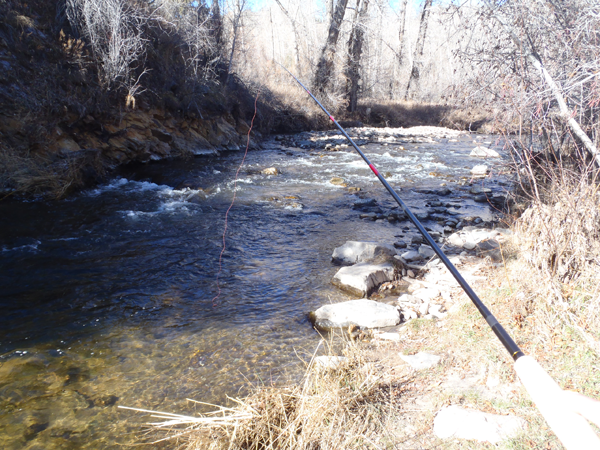
I anticipated that like my Tenkara USA Ito (which is a 2-way zoom rod), these rods would become exponentially tip heavy as they reached their maximum length. But they didn’t. Whether you’re in the shortest or the longest position, the rods maintain their airy feel without tip heaviness. This is no doubt another benefit of the higher modulus graphite.
Unlike most of the current Tenkara USA rods, these blanks are not sanded or painted and are a beautiful black color with red bands between the segments. The blank features markings for each stage so you know at which length you’re fishing …
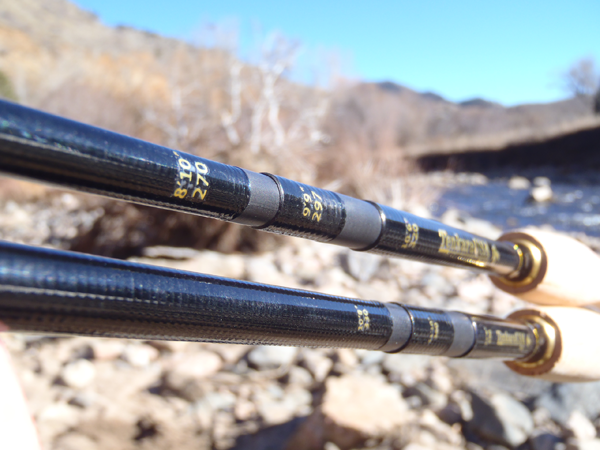
Handle
While the grip is a little shorter on the Rhodo, both have the same shape. There are ergonomic bulges near the top and bottom that make for a very comfortable grip in either position. I frequently hold my rod right at the bottom so was glad to see the handle flared there and in just the right thickness and length to fit the palm of my hand as if it were made for me. The cork also appears to be of better quality than some of the current Tenkara USA models. Sato grip (top) and Rhodo grip (bottom) …
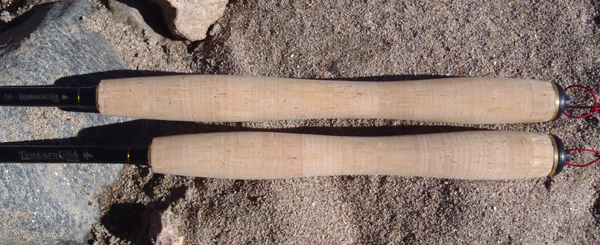
Rod Plug & End Cap
Unlike the wood/rubber rod plugs the company typically uses, these rod plus are completely wood with an attached red cord loop (the kind that first rolled out with the now discontinued AYU II).
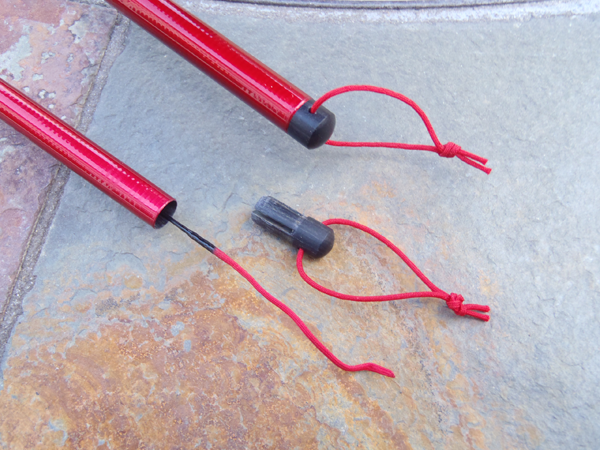
The cord serves 3 purposes: it makes the rod plug easier to find if dropped, it gives you a way to attach it to your chest pack or other gear so you won’t lose it, and it serves as a backup lilian if yours falls or breaks off. Click here for a video on how to do a quick field repair.
Most wood-colored rod plugs would be impossible to find when dropped but the red cord makes it stand out …
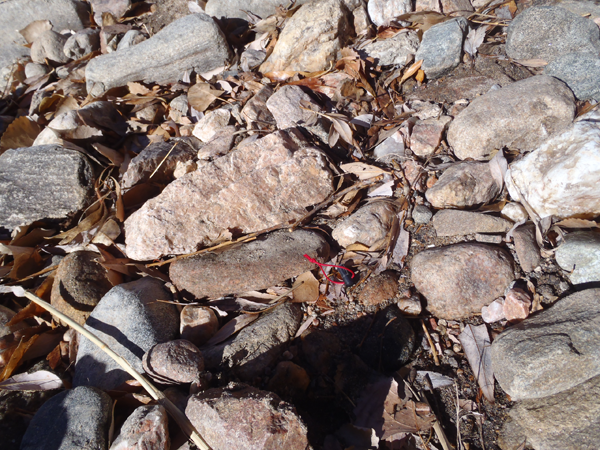
This rod plug design may not be revolutionary, but the new patented end cap is. It holds another rod plug so that if you do lose yours, you’ve got a spare. And, it’s also got another spare lilian. Brilliant! So now, every time you take your rod out you’ve got two rod plugs, and two spare lilians. It would have to be a pretty disastrous day if you had to use all four of these redundancies but if you did, you’d be glad you had them.
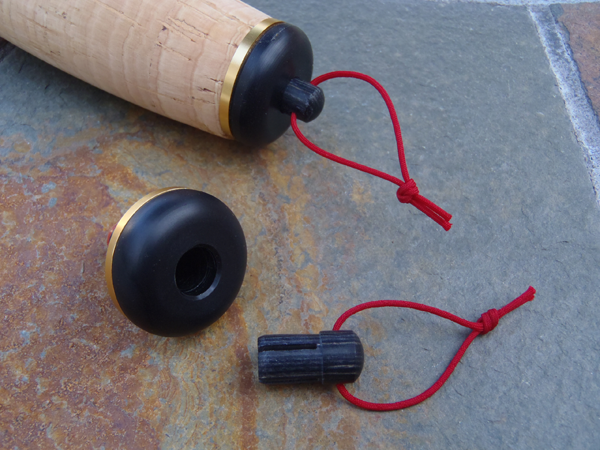
I also see another benefit to this design that maybe wasn’t intended. If you wanted to, you could remove the spare rod plug and keep it somewhere else (eg. attached to your pack) and use the hole in the end cap as a handy place to store the original one you take off while you’re fishing. In case you’re wondering, when you remove the spare, there is a hole left but the rod segments don’t slide out because it is sealed by a cushion. I’m probably more apt to use it this way than to leave the spare in there all the time since I rarely lose a rod plug, but am always looking for a place to store it while on the stream.
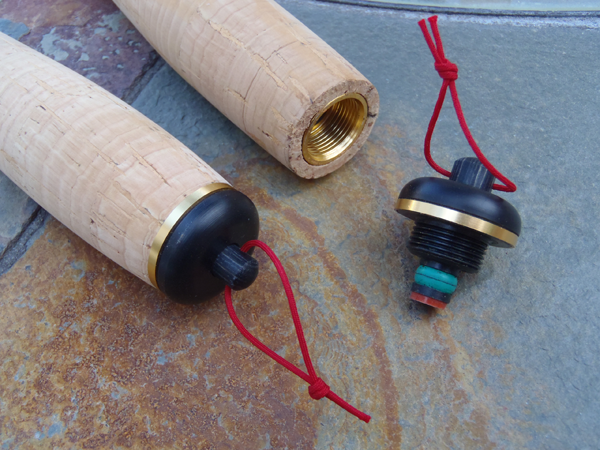
In addition to this clever feature, another difference from current Tenkara USA models is the material. All of their rods employ a metal end cap but this one is nylon. I imagine this is probably for weight savings. At first I thought it looked cheap but then I realized that it would be a lot more scratch and dent resistant than many of my metal end caps that now look like they went through a demolition derby so it seems like a practical choice of material to me. My only complaint about it is that it doesn’t have any knurling around the perimeter which might make it difficult to remove if you’ve screwed it on too tight or have wet or cold hands. Seems like that would be an easy thing to add to the molding process and wouldn’t add any cost.
Case
Both rods come with the standard-issue Tenkara USA green fiberglass rod tube with aluminum caps that open at both ends though it looks like they’ve added rubber cushions inside the caps for added protection and to cut down on noise. A Velcro closure “velvet” rod bag is also included.
Action
Now for the tricky part. As I’ve recently written, I think rod action is something that can’t be accurately described objectively—it really has to be experienced. Keeping that in mind, imagine how difficult it is to try to describe two different rods, each with three different lengths!
I’m sure at some point, someone like Tom Davis will put these rods through a more scientific analysis such as the common cents system, but for now all I can do is give you my unapologetically subjective impressions and observations.
The Rhodo
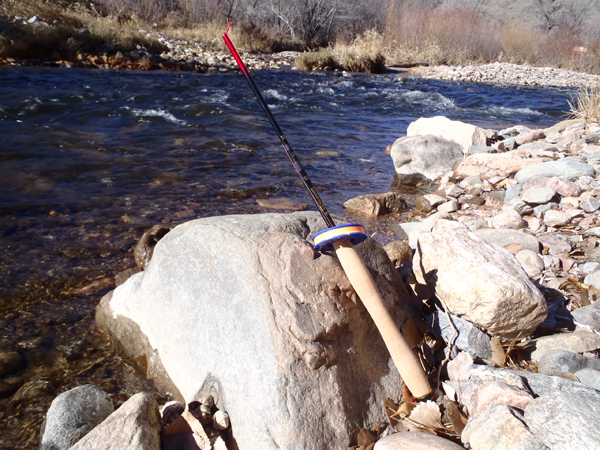
The first time you hold the Rhodo, it’s immediately apparent that it’s a small fish/small stream rod. It’s so light in the hand that unless you give it a good wiggle, you could almost forget that you’re actually holding something. Overall, the action is very responsive. It’s “fast” in the sense that it recovers quickly when loaded, but definitely doesn’t feel “stiff”. It’s a very delicate feel that makes fighting even a 4” brookie a blast.
I fished this rod with a variety of fluorocarbon level lines as well as a 10.5 ft. furled line. To me, this rod starts to get a little overpowered with heavier lines like a 4 or 4.5. I think it really performs best with a 2.5 or 3 level line. You also need to consider that with longer lines you’ll want to use a smaller diameter to avoid overload. To me, the Goldilocks line for this rod is a 2.5 level line between between 10 ft. – 13 ft. though those who prefer traditional tenkara lines will be glad to know that it casts very smoothly with a tapered furled line. I think people who fish dries on small streams would find that the ideal combination.
Here are some of my impressions at different stages of zoom:
8’10”(270cm)
At its shortest length, the Rhodo feels like a delicate full flex rod. This is because the two thickest segments are still in the handle. The rod loads and unloads very easily and I felt that I had to slow down my cast a little to allow longer (i.e. 13 ft.) lines to turnover. You don’t have to slow it down if you use a line the same length or shorter than the length of the rod. This stage is truly a small stream rod and it would seem to me that you’d naturally want to use shorter/lighter lines anyway.
This is the length that will put a smile on your face. It’s just plain fun to cast and land fish. But that smile will quickly turn to a frown once the wind picks up. It just doesn’t have enough backbone to overcome a strong gust. For that, you’ll need to zoom it out.
9’9”(297cm)
Once you zoom out to the next position, the rod has a little more backbone and you can speed speed up your casting stroke. It’s a very subtle change, but noticeably different if you’re really paying attention and gives you the ability to throw a punch back at the wind or fish longer lines. While I like the action in this mode, I kind of miss the playful delicacy of the Rhodo in it’s 8’10” mode. But like giving up childhood for adulthood, it might just be something you have to do at a certain point when the conditions demand it.
10’6”(320cm)
At full zoom, you’ve now got the two thicker butt sections of the blank to leverage against the wind and longer lines. It also helps balance out the rod length to line length ratio (i.e. it picks up some slack line) which will help with turnover. Surprisingly, when the Rhodo is fully zoomed out, it doesn’t feel tip heavy at all. In fact, it still feels lighter than many non-zoom rods of equal length that I own.
But at this point, it feels less like a dainty small fish rod, and begins to take on a more all-around (dare I say 6:4) action. The combined extra length and added backbone make this stage more versatile, whereas at its shortest length, the Rhodo is really what I would consider a specialty rod for small, brushy streams.
The Sato
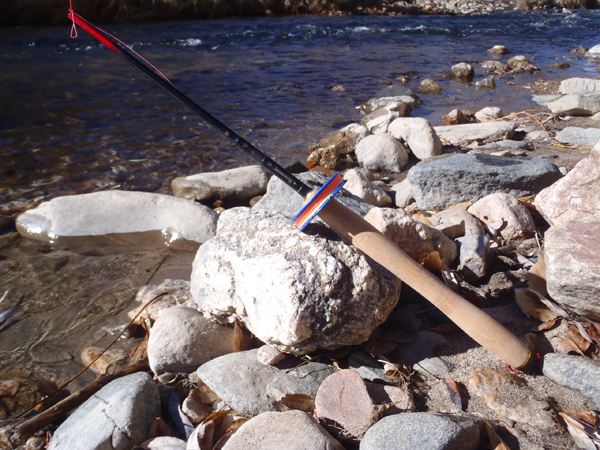
Despite its anorexic blank and ultralight weight, the Sato is very obviously a more all-around rod than the Rhodo and its personality immediately won me over. Its action reminds me very much of my beloved Oni rod—unbelievably light, crisp, and very accurate. I fished it mostly with a #3 16 ft. level line (because that’s one of my go-to lines) and the rod performed perfectly. It executed every cast as effortlessly as my Oni rod does and I felt that even though it was a brand new rod, it was already familiar.
While I really like using a #3 with the Sato, it can also handle lighter lines or even a heavier line like a 4.5 if you need to punch through the wind. But I feel like this rod was designed to perform well with lighter lines as the Oni rod was and that’s really where it shines.
If I had to classify it according to the Japanese rating system, I’d have to say it’s probably a 6:4. Like the Rhodo, the Sato is crisp and responsive without feeling too stiff—it’s just a bigger rod.
Here are some notes on the Sato at its different lengths
10’8”(330cm)
Here the rod feels its softest, but definitely more powerful than the Rhodo, and definitely not like a specialized small fish rod. With a line about the length of the rod, you won’t have to worry about wind, but when I used a 16 ft. line, I felt I had to zoom the rod out to get better turnover. I think a lot of people will like the “default” action of the Sato in this mode but will also appreciate being able to zoom out to longer lengths when needed.
11’10”(360cm)
Again, like the Rhodo, once you get a little backbone in the rod, it can turn over longer lines and overcome the wind while still remaining very light in the hand. For the streams I fish, the shortest stage doesn’t really give me any advantage so I prefer the extra length and backbone. This is where the smiley face when you first cast the rod gets serious and turns to two dots and a straight line. OK, I’ve had fun, now, let’s take it up a notch…
12’9” (390cm)
This is the length I found myself fishing the Sato in the most (probably because I’m used to fishing a 13 ft. rod). I actually prefer its two longer positions to its shortest. While the short mode is fun and I could see myself using it in certain situations, I feel the little extra backbone is better at turning over the longer lines I use and the extra length is an advantage on the wide open streams I typically fish. Since there’s no weight penalty for fishing it at its maximum length, I will probably use the full length 90% of the time and will zoom it in only if I need to shorten up my casting distance a little.
An interesting phenomenon
I was having a conversation with Anthony Naples about these rods, and we both noticed something interesting. It’s going to be hard to explain but I’ll try. The aforementioned Ito feels like a completely different rod depending on if it’s zoomed out or not. But on the Sato and the Rhodo, we didn’t experience that. Even between the minimum lengths and maximum lengths, they don’t feel like “different” rods. They just feel like different lengths of the same rod. That probably doesn’t make a lot of sense, but if you reread this passage and then go actually cast each rod at all three lengths, I think you’ll know what I mean.
Part of this could be the different graphite, the different lengths, or the fact that these rods don’t become tip heavy like the Ito does. But I thought it was worth noting.
Final Thoughts
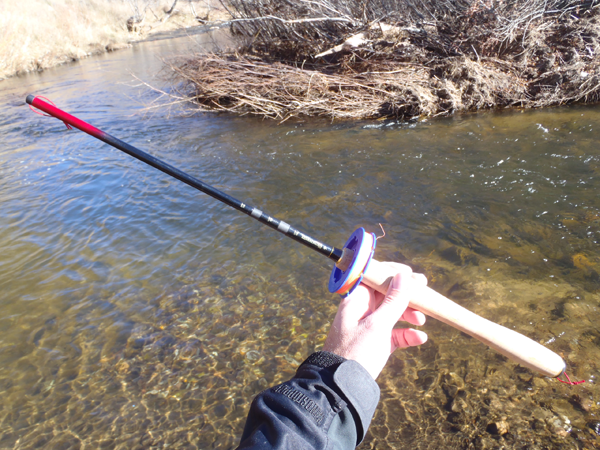
I still think that rod reviews (including the one I just wrote and you just read) can only tell part of the story. You have to get a rod in your hand to feel it. You can read all the reviews and other people’s stats you want but that will never tell you if you’ll like any particular rod. So, take this review for what it’s worth–just my opinion. As much as I would like to, I can’t put the Sato or Rhodo in every tenkara anglers’ hands. But, if your in the Denver area, I’d be more than happy to bring them out to a Starbucks for some parking lot casting so you can see them for yourself. Contact me here.
I’ve decided to make the Sato my new go-to rod. I love the action every bit as much as my Oni rod, but if I break it, it’s easy to replace so I won’t have to be nervous about fishing it. Plus, I like the contoured shape of the grip better than the straight, foam handle on my Oni rod. I’ll still fish my Oni on special occasions, but since the Sato does everything I want it to with the same finesse and feel of the Oni rod, it just seems to make more sense.
I probably won’t use the Rhodo that much, only because the streams I fish don’t require a short rod. However, I will take it out once in a while just because it’s such a fun rod to fish. I also see many bluegill in its future.
I have to be honest. When I first heard Tenkara USA was coming out with new rods, I really expected something more like a minor update to the Ito or Ayu or something. I really didn’t expect anything as radically different as this. I can’t imagine the amount of design work and testing that went into these rods and I hope this is a sign of new (real) innovation to come from the company. If there were a “Tenkara Gear of the Year” award for 2014, I would nominate the Sato and the Rhodo in the blink of an eye.
And in case you’re wondering if I think these new rods are purple cows or not, my answer is simple. Mooooooo!
For another perspective on these rods, check out Tom Davis’ review on Teton Tenkara.
For pricing and more information on the Sato and Rhodo, visit Tenkara USA.


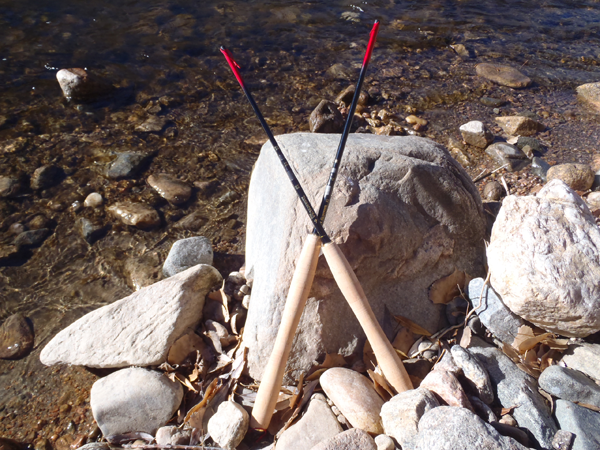






And looking at pricing, once again the bar has been missed. I just don’t understand the mentality of leaving the economy/lower income anglers behind. For the life of me, I can not understand this.
I was seriously hoping that the “game changer” rumors would mean that we would start seeing sub $100.00 rods.
It sounds as though the elitist trout angler mentality prevalent in Western style (“But I have a $900.00 rod and $650.00 reel to catch a 2 pound fish”) is going to continue into Tenkara. Damn shame…
Rick, I don’t think you could develop and build this rod for a $100. Besides, there are already tons of rods out there in that range and below so I think it’s ok that they come in at a mid-range price. Frankly, I didn’t even know how much they would be until today and actually expected them to be more in the $250 range rather than $215.
Excellent review! I agree about these rods being a wonderful direction for Tenkara USA.
Look like nice rods. The smaller one in particular fills a niche. However I agree with the first post. For this price you can nearly lay in a premium JDM Nissin 320 Zerosum with the great current exchange rate or buy one or something like it from Tenkarabum. Big profit margins in the T USA rods. Granted you are paying for a fantastic warranty – sounds like you might need it with the 3 way zoom. I simpoly feel this rod and all of their models in fact, should sell for 50% less. Good luck to them. And if these are purple cows, Chris has the biggest cattle ranch in Ney York City.
Hi Dan, I looked up the prices of the Zerosum on Chris’s site and they range from $270 to $325 so I guess I don’t see how it competes in price.
I’ve never tried a Zerosum rod so I can’t comment on how it compares is action or quality either.
I think one thing to keep in mind is that it’s sometimes difficult to judge value on something until you get it in your hands. The moment I held the Sato in my hands I knew it wasn’t going to be a $100. And I’m glad. We’re flooded with cheap, mediocre rods and I’m glad to see something different.
But innovation costs money. And it still doesn’t even come close to what regular fly rods are going for these days. The new Sage rods are going for $775! You could but almost 4 Satos for that!
My guess is that once someone actually fished these new TUSA rods, they would have no qualms whatsoever about the price. I guess we’ll see once people start getting them in their hands.
Thank you Jason. Another fine review.
I think the price point is damn good. The price may not be the game changer but it appears that TUSA definitely came to play zoom with Nissin and Shimano.
Rickles,
I do not understand. How can you say that this is reserved to an elitist angler? With Tenkara you are already cutting the cost of $70 fly line and $80+ reel out of the equation. Plus, the average cost of a tenkara rod is about $400-$500 less than the average cost of a western fly rod. Already being a tenkara angler is way cheaper. Also, the Iwana from TUSA is cheaper than these new rods and will satisfy your angling needs, big and small fish.
There are cheaper tenkara rods out there…..on ebay, but if you want a product backed by the best company for tenkara, you are going to be paying more than the economy price.
BTW, these rods look awesome! Especially the SATO. Maybe we’ll go out and fish Jason…..
hese are not “game changers,” IMO. 2-way/bi-zoom rods have been around for a bit, and at first glance the Sato isn’t much different than the Suntech Suikei but for a cork handle. The “Keep Your Plug” system seems superfluous, too. Kinda cheapens the spirit of simplicity and minimalism TUSA has been all about. The Rhodo raises my eyebrows most, but only because it’s a bi-zoom rod at shorter lengths and fills a previously empty space in the growing ocean of rods to choose from. Then there’s the upward price point. These rods will certainly stand out from the herd, but “purple cows” they are not. Of course, I’ve not held either of these rods in hand yet, nor fished with them, so, haters gonna hate….
Neil,
A 3-way zoom rod made of high modulus graphite with TWO patented technologies the world hasn’t seen before in an ultralight weight at an $200 price point isn’t a game changer? Jeez. Tough room. Out of curiosity, what features in a new rod would you consider a game changer?
Perhaps you are right jason. If they feel that good in your experienced hand they are worth every penny. I do like the warranty. If my zerosum breaks I am out lets just say over 200 bucks (we all have our sources). Great review . Thanks for your reply. Dan
Cerelli,
That’s kind of my point. You can not base pricing of Tenkara rods based on Western gear. There is no comparison between the two. It’s a simpler system (not saying it’s less complex to make).
It’s just my opinion, but the pricing is getting out of hand and is chasing away would be Tenkara anglers just as happened in Western Fly.
For example, I’m a huge TFO fan, and believe me, they got an earful from me when they introduced the Soft Hackle.
Is the graphite gold impregnated high modulus rolled on the thighs of virgins? Is the cork gotten from the far ends of the galaxy on a one of a kind space mission? It’s pricing for the sake of being vulgar. (or trying to recoup manufacturing/tooling costs on a first run only to lower pricing down the road)
Make a GREAT product at a reasonable price and you’ll make up the difference on sales. Over price your product (or over complicate it) and your sales will drop on the product making it a loss.
All this type of pricing does is further the gap in the sport we all love (Exactly what happened to Western Fly with high priced gear and manufacturers dropping lower cost models).
I read an article not long ago by someone in the Tenkara anglers group and his prediction was exactly what’s happening. Over pricing gear to keep up with imported items (when your product is arguably already far superior) is just dense.
Comments on zoom are pretty much spot on too. Dad told me when I was a kid fishing and fussing about the line length/rod length. Move your lazy ass 🙂 Seriously though, the rods are light enough and given the lack of complexity and needed gear, there’s simply no reason for a zoom rod – carry an extra rod of a different length – you’re already a pound lighter than you would be were you Western fly fishing and carrying another rod.
I’m not picking a fight and these are just my opinions. I don’t think that the market needs are being met, and seemingly it’s only gear porn that is driving the Tenkara market. Is there any real innovation here?
Rickles,
I totally respect your opinion. I can see what you meen by the widening gap in tenkara industry over price. Not that i happen to agree with your opinion, but I do see the points you are making. And no, I do not think your points are stupid or invalid, I just happen to believe there are other factors in tenkara, the industry, it’s buyers and manufacturers that are far more than what we know that out weigh the validity of your points, and even my points! For now, these purple cows are going to help anglers who may not be able to “adapt” to situations (like you mentioned..move your a**) who maybe do not have the desire and drive others may have. I think it helps Tenkara.
Jason, are you saying the SATO is your rod choice over the Ito?
Cerelli, I will probably still fish the Ito on occasion because I love its personality (same with the Oni). Sometimes I just feel like fishing a certain rod on a given day. But the Sato really fits my casting style so well I think I’ll be reaching for it 90% of the time.
Well now i really want to try the Sato! The Ito fits my casting style the best so far. Sounds like the Sato may be a great companion to the Ito.
I’m really surprised with the price point comments. Look at it this way guys. An entry level rod which price point and materials reflect it’s value. I’m not going to mention the name, but I will say that I have owned a few rods from this line and others from the company as well, and for the prices I have no complaints.
270cm cost = $85.70
300cm cost = $83.50
330cn cost = $90.10
total cost = $259.30 and you still just have extra weight, extra clutter, no warranty, and entry level technology.
I think the new rods seem pretty cool, well made, and provide more versatility at a good price.
At the dinner table my mom used to say to me “don’t knock it until you’ve tried it”.
First off thoughts on the rod. Beautiful addition to an already great line up. I believe it is a great way to combat the other zoom rods becoming more popular by Tenkara anglers, thus great move by Daniel. I also believe them to be worth every penny! The support given is exceptional, from my own personal experience. Now I will give my opinion on what I take from Rick. I think people are looking for TUSA to offer a rod more suitable in price for a beginner, even though there are plenty of great alternatives for this. The point is to feel as though the people who can’t afford the higher prices, however less expensive it is in comparison. This may give some a feeling of elitist. I’m not saying that TUSA is by any means as my experience had been superb. I guess bottomline is a lot of people would like to see a ququalify rod from the top manufacturer for a value introductory price, aka rod on a budget program. I had a hard time deciding but still love the rod I chose after fishing with it first. This creates a different problem where a customer usually doesn’t get to touch a rod before purchasing. Like to thank Daniel for looking for ways to continue innovation, this can be a hard and challenging task. Let’s see what other kind of innovations will follow.
Brandon,
You know what? I think social media, free cloud services, and web 2.0 has spoiled everyone. People want everything for nothing now. They’ve lost their sense of value, dev, and design. I’d like to see someone else design a 3-way zoom rod from the ground up with TWO patented technologies the world has never seen before and sell it at a $100 price point. That’s not a game changer? Really? Tough room.
If it were 20 years ago, we wouldn’t even be having this conversation. We’d be blown away by the innovation and ready to open our wallets for such high-tech rods. I think people (not you Brandon) need to put it into perspective.
Without casting the rod I would say on the surface it looks good. Of course the proof is in the fishing. While of course I wish the rod was more economical I don’t find it out of place for the value promised. Higher modulus material cost more. With Tenkara USA product line running between $160-$240 I would say $215.00 for a higher end rod is right in there. Should a person want a couple of rods with different lengths a person can save money with this option With traditional fly rods a person can find themselves with a few different rods for different applications. That makes a “one rod does all “ Tenkara version a bargain.
The zoom option may offer value for some. I personally would simply prefer to get closer MOST of the time. However I have found a few fishy area’s that were a challenge to close the difference a few feet closer from a safety or stealth standpoint. In that regards a few extra feet is a nice option.
I agree part of the cost is the built in warranty. In this case I actually support that cost. As Tenkara is new and continues to grow people will look at these rods as a potential “problem” until they find out they are not. Let’s face it , they do look “delicate” on the surface. Backing that rod 100% with a no hassle policy will help encourage people to enter the sport. Right now growing the sport is a benefit to all of us. Where would all us Tenkara lovers be if companies failed due to lack of growth?
Plus Tenkara USA donates a percentage of sales back into the environment. I suppose they could knock that of the price of the rod as well. However again, I’m happy to pay it. While other companies based in Japan may offer rods at a similar price point one has to ask how is service dealing ½ way across the world? How much do they donate back to OUR or their environment?
I’m no fan boy of any one company but for me the price is right and the company walks the walk. I like the traditional eastern feel of the sport. However I would also appreciate an equally focused effort to come out with some “western” Tenkara rods as well. For example a Czech nymph style Tenkara rod would be an outstanding tool.
Well I will definitely say, TUSA separated themselves with the Ito, and now with the Sato and Rhodo that gap is much farther! No other company can reach TUSA. Most other rod importers cannot touch this innovation. Love the keep your plug bottom cap!
I’m really appreciating the discussions about the rods we just released here. Also, thanks for the many kind comments, and for the constructive feedback posted in here. I may not always respond, but I always read and take comments to heart and try to act on them.
I see a common thread in these comments is pricing. Without getting too much into it, it takes a lot of money to develop a rod, and a lot of money to use higher grade components. We could save almost $10 of our own cost on these rods by using cork that was one grade lower!), just to give you an example. Same with carbon fiber, which we went for the highest we could and made sense for these rods. Since you have been asking for a lighter rod, and also expect (as we do) a rod that won’t break easily, that’s what we were able to create.
My comment is getting longer than I intended already. Mostly I started typing to respond to one common misconception about fishing rods in which customers assume we have the warranty cost “built-in” to the rods. Perhaps it’s not so much a misconception as a concept that does not apply to us. All I can say is that I have never, EVER, looked at the potential cost of repairing/replacing/sending replacements when figuring out pricing for the rods. It just does not factor in, certainly not in the way some may imply.
Warranty costs come from a different calculation that may go like this: we want to acquire customers, if customers break a rod they won’t be happy with us and won’t buy from us again; further, if they break a rod they will not be able to show their 5 friends their rod, so we lose on sales and can not do anything. I suppose we can say warranty costs comes from our marketing costs. But, of course, we could just get rid of it all: no more warranty, no R&D, no promotional materials, no travel, no labor to assemble the rods,no hiring, etc. That would give us a super super cheap rod…We’re a pretty frugal company, currently all staff works from home in different parts of the country, and we really try to balance it all to give you the best possible price for the best possible rod (AKA, the best possible value). After all, our mission has always been to introduce the largest number of people to tenkara, and we will not be able to do that by overpricing our products, though we also wouldn’t be able to do that if we had underpriced our products, or if we had just decided to offer cheap sub $100 rods that break easily.
Dear Jason,
Do you really think those of us who feel the new TUSA rods might not be a great bargain nor phenominal technical advancement make our comments without regard to perspective? I am sure they fish well. Certainly will sell like crazy under a well-tuned marketing plan and exceptional warranty policy. Glad they sent you a couple and you are impressed. Obviously I have not tested the rods, however I choose to take a “knock it and not try it” approach to these offerings. Perhaps I draw from my experience with a rod from this company which I owned in the past and thought was mediocre compared to others I fished. Could be I am familiar with alternative choices that offer apparent similar charactaristics – some at a lower price and some more costly. In any event, I am a firm believer in the following quote “…..from the clash of differing opinions comes the spark of truth.” That’s why a tend to stir things up a bit here and there.
Jason I would tend to agree with you that we have been spoiled! The price is a stretch on my budget not what the rod is worth. I also appreciate Daniels comments. As a small bussiness owner it is often difficult to find the right balance, but never cut corners jsut to get the cost down. I’m a believer of quality first, and TUSA has great focus on this. I believe the future is bright for Tenkara and the opportunities it gives us to continue to grow and share our love and passion with each other and others who haven’t had a chance yet. I love the innovation and look forward to the time I can finaly get one in my hands, hopefully sooner than later! On a more personal note I really want to see what line best matches these rods. It’s my addiction!
A well written article/review Jason..
Now if I only had about $255 to spare..
Brian
you can’t get quality for peanuts. I’m sorry, but the price point is sound. the cheaper rods (a) are lower quality or (b) don’t come with the rod replacement deal. simple fact. and, you pay a lot more for high end rods of other brands, remember.
but, as someone pointed out, rightly, these are VERY cheap by comparison to western gear. apart from a $85-120 line and $300-600 reel, a top end rod costs $800+, and a great rod in the lower range is still above $300. i.e. quality costs money.
I’m yet to trial one, but have ordered a couple already. I am interested in comparing them to onis, nissin airstages,and the originals, iwanas. not just casting, but fishing ability (landing, versatility in flies from dries to kebaris to weighted wets.
Jason, you must still own an iwana 11 and 12, how do the satos compare? softer/lighter in the tip, slightly less in the guts for big fish, I suspect? stiffer profile?
How many rods? One more than I have.
I think these rods are a great adition to a great TUSA line up alreay. While I am unable to order a rod right away, I will get the Sato before our trout seson opens in March in WI.
Price: I don’t see a problem with the price for what you are getting. I am fishing either my 12′ Iwana or my Ayu II. These two rods new are more than the price of the Sato. Based on the price, I can get three very usable lengths for me for less than the price of my two most used rods. Also taking into account that these are zoom rods and if compared, zoom rods by other manufacturers aren’t cheap. I also like the fact that spare parts are easy to get via online, and there shipping is fast. I have had to use TUSA’s warranty service once for one of my rods. The service was first rate!!!!!!!!!
I think these two rods are a great and can’t wait to order a Sato for myself.
Comparing apples to ornages western rod reference: Sage $700 and overpriced. Echo Solo made in China, lifetime warranty (and a good one) designed by angler with 30 years experience, includes bag & case – $119. I agree that R&D for the zoom feature may have added a bit to the new TUSA rod cost, however zooms can be found on JDM Tenkara/Seiryu/Keiryu rods in the 12000 yen range. And a triple zoom is not like having 3 rods. It is a nice feature, but really not 3 rods. Again, please trust that some perspective was involved in my thought process.
“Ornages” really now danny. sorry for the typo
good times. =]
it always cracks me up how easy it is to get focused on the minutia. step back and think about something for a minute. we are only maybe six years deep in this pool. what i think is stupid amounts of awesome is that, in this very short time, we the tenkara anglers, tinkerers, entrepreneurs, consumers, hobbiests, and all have a burgeoning list of choices. that, my good fellows, kicks ass. thank you tenkara talk and tenkara bum and tenkara usa, and…everyone of you who reads this. the ride is only just beginning.
p.s. great report jason.
A review and exchange of ideas is minutia. Otherwise all we would get from this conversation is: gee great rod at a fair price or good rod but overpriced. I appreciate all the comments here.
Just to round out some sharp edged comments going back and forth…….I think you are all wonderful people. I mean, you chose Tenkara! Everyone of you probably love it like I do! So as much as I like a good hearted brainstorm/constructive argument…..just remember, we are all Tenkara anglers. No need to get our lines in a tangle……or in a branch…..or around a submerged log….or in the bush behind us…..well you get the point.
my point isn’t that the “review and exchange of ideas” are incidental. my concern is that some may be splitting hairs, cutting off noses, and/or missing out on the forest. coke or pepsi? mcdonald’s or mcwopperking? niners or cowboys?…well cowboys of course, but i digress. i can’t speak for everyone, but i fish to get away from life’s gnawing. tenkara has come along and made something i’ve loved since early childhood into something even more loveable.
like adam h. has so eloquently put it, “i think you are all wonderful people.” it is obvious from your posts that y’all are all informed and upstanding members of the tenkara tribe with fantastic perspective. some may probably look really great in corduroy pants, too. which isn’t easy they say. yes, there are arguments to be made for this price or that rod. heck, we could all easily take sides and have an old fashioned rumble, but for crying in a bucket, it’s my birthday and i just can’t take any more of it!
I’m going home now and eating a lobster.
Well said Mike and happy b-day Tomorrow is my 60th birthday. And I might just order myself a made in J 3-way zoom Keiryu rod with already existing technology (price 12800 yen incidently). Game changer for TUSA. For some of us simply not. Not trying to “get anyones line in a tangle” just not buying all the hype. Like I said before, nice rod and glad most of you want to try one.
Well, once again it all boils down to Capitalist/American consumerism/greed. It REALLY took YEARS to develop these 2 rods?! I have seen many adjustable length rods. Putting a hole in the handle to hold the plug? Easy (not worth the price of a patent) Still using the spool line slipped down the rod? Archaic! No built in line keepers? silly!No Easy on, easy off connections for lilian and line? Dumb! Where is the spirit of American innovation and uniqueness??? Daniel and co. don’t take offense but i expected SO much MORE from your team with all the anticipation and hype. (sorry Jason, im just not “buying” into this false bravado!)
Jason, my friend. When you tried out these new, super rods, how much did you pay for them? Or were you one of the truly “chosen” to freely get to try these out? Unlike the rest of us who must pay full price for them?! After all you posted about the Purple Cow blog and all the ideas i sent you and many others how is this Tenkara USA something great? (Don’t get me wrong I think Daniel and his associates & Co. are awesome!) However, after seeing all his posts on FB I feel he has to much $ and spare time on his hands…ahhh the American Dream! Mine and the others ideas were simple and inexpensive, how and when will they get implemented? I guess were on our own as in DYI, eh?
False Bravado? REALlY! Tough crowd is right. How is Jason the bad guy?
I’ve got only one more thing to add; info@tenkarausa.com
Ok, one last point, check out Chris’s subtle post on Tenkara Bum about what $215.00 can REALLY buy you! Hmmm, where have we heard the figure before??????
This is a no-brainer for me! It will be a Sato for me! And $215 is a great price for what they’ve put into it, my opinion. I’ve wasted way more on other useless fishing gear.
JDSMITH, what are you talking about?! I NEVER stated that Jason was the bad guy?! I think he is AWESOME and “spot on”. And then you said,”I have only one thing to add” with a link info@tenkarausa.com and all it is, is a email address????????
Timmy, I will freely admit that I got the rods for free. You seem to be implying that that influences my review. It doesn’t. I get free gear thrown at me all the time and I don’t post about it because most of it is garbage. My goal is to inform the tenkara community about cool, new, interesting gear that’s out there. That’s all. I have no affiliations or back door deals with anyone. When I say something is good, I really think it’s good. But when it’s junk, I will spare you pointlessness of writing about it (for example, I’ve got a pile of lines on my desk right now I consider worthless).
Scott Tidwell, no brainer is right! You want to waste your hard earned money? go ahead. (If your married im sure your wife would say WTF?!( Check out what you can buy at Tenkara Bum for $215, silly boy!)
Here’s a great idea, let’s blame the blogger, bash the manufacturer, point people to “the other guy” and moan about why our ideas don’t get added to the rod build, Pfft!
I like the ideas behind this rod and the price is what it is, if it’s too high wait for a sale or hope someone hates it and puts it in the classifieds. Looking at the images I don’t like the finish all that much but I’m interested the functionality of gear and these rods look great in that area. All the comparisons between sage/hardy/orvis and tenkara rod prices is also pointless, they are different tools and just because a tenkara rod is cheaper than some fly rods doesn’t make it good value for money.
All the bashing that goes on in the tenkara “Community” (fight club) is a real turn off, TT is the only tenkara website I ever comment on anymore but I’m losing patience with the negativity here now too.
Thetroutfly,
The negativity has nothing to to with tenkara. It’s a symptom of social media. You should see some of the bashing that goes on in some of the backpacking or tech forums. This is nothing. Tenkara social media is civil in comparison. So please don’t let it tarnish your view of tenkara. But feel free to let it tarnish your view of human nature. 😉
Gentlemen. It’s fishing. It’s a pleasurable pass time. Stop already with the gear. We seem to get so hang up with materials and forget the enjoyment fishing brings. Give the rods a try and offer your opinions.
@ timmmay!: man-o-man, does someone need a hug or what?!
@ dan h: thanks for catching my drift. hope you have a great birthday.
@ thetroutfly: word.
@ jason: how do they fish compared to your kawa?
and a p.s. to timmy: sorry dude. i could not resist. further, i honestly want to agree with some of what you are saying, but in your own words, “WTF?” scott could have also bought products from chris’s site for all you know. it seems there is indeed a rift in the tenkara world, and to me it is a damn shame. if you are not a part of the solution then…
My 2 cents on some of the additional comments
Warranty. Not sure how that is not calculated into the cost of the rods. Warranty is generally an expense that is carried on the books and as a result calculates into cost of goods sold.
Worthless patents? Everything is patented for various reasons. Some are never produced. Even the plastic do thingy that keeps the pizza off the top of the box is patented. The inventor makes millions.
What does $215.00 buy you? For $198 you can be fishing with an Iwana Kit from Tenkara USA. Need tippet but you have another $15.00 to play with? Both companies have value and high end rods available and both are pleasant to do business with.
Not sure why people think this is a negative conversation. Simply opinions from various points of view.
@michael: here, here.
Mike W., Jason and all. I thought blogs and forums were places where we could be honest and open, passionate and express our opinions in coolness or the heat of exchange? I don’t believe any of us are intentionally trying to hurt or offend anyone. Sometimes in the “heat of battle” some of us go a little overboard and for that iam truly sorry. For my part it seems there are so many awesome ideas and innovations out there, im having a hard time understanding why its so difficult to employ them. And it seems to take forever! Cookie-cutter cows we have a lOT of, but so few purple ones, sigh. Mike, maybe i will take that hug now. Im truly sorry if i hurt anyone in the Tenkara community. Some have unfriended me on FaceBook, i was not intentionally trying to offend anyone. 🙁
Hi Jason,
Thanks for the response. These rods are not game changers to my mind, only because I’ve been fishing zooms for the past year (especially Suntech’s Suikei and Field Master). Again, I’ve not so much as touched either of these new rods, but from the initial reviews it looks like the Sato doesn’t much differentiate in terms of action from the Suikei (which is not to say that the Sato is the same as the Suikei or that it’s not an exceptionally made rod all by itself. I’d love to see, say, Tom Davis, do a “head-to-head” comparison of the Sato and the Suikei). The Rhodo, on the other hand, differentiates by virtue of the fact that there is no other zoom rod that fishes at ~270/300/320cm lengths. I happen to fish those rhododendron-crushed streams in the East regularly, and 240-320cm is the sweet spot lengths I like to fish them. So, maybe I misspoke. If I owned a Rhodo, it might change my experience fishing those streams for the better, and that appeals to me.
As for the two new patented technologies, I agree there is accomplishment here. But the Keep Your Plug system appears to be more than what is needed for a day’s fishing. The extra top cap and extra lillian seems an unnecessary redundancy, while the new end cap appears sound (as a place to put the original top cap while fishing…as long as it doesn’t pop out while you’re on the water… again, I’ve not fished with the rods to know how well it works…). Still, redundant features are not what I value when fishing Tenkara. I don’t find myself saying, “All I need is a rod, a line, a fly…and an extra top cap…” to fish Tenkara. I know you know, newly patented technologies don’t always make a product better.
$215 is not excessive to pay for quality Tenkara rods like these, and I don’t think one can design, manufacture, market, ship, and support them for peanuts. You get what you pay for. But I think this price does reflect the steady and slight upward tick common to what many consumers are experiencing these days, and that’s disconcerting.
What features would I consider a game changer? Sonar in the blanks that pings to detect fish. Laser sighting lillian. An electro trout stunner built right into the handle so I can just lower my rod and zap the bastards when the fishing gets slow….all at a sub $200 price. Kidding aside, I guess I’m not looking for game changers, just products that work best for how I personally like to fish. And these rods might just do that (even if I could do without the Keep Your Plug system). But if I don’t piss and moan about what I want for how I like to fish, the solid products don’t get made, right? So, yeah, it is a tough room.
Thanks,
N
Michael, Thanks for the rational and logical thoughts put in your comment. I should mention about calculating warranty into the costs. Indeed warranty and customer service are a cost. What I meant is that I have never looked at it specifically as something that needed to be added when pricing the rods we make. I figured if we make bad rods that are breaking all the time then we should lose money. There is a profit margin into rods that goes to support a lot of things such as customer service, R&D and all the other stuff, if our rods are bad they will eat into it. If they are good we can spend more on R&D and other costs.
P.s. Tim Plunkett, I have posted a lengthy response to your comment in our blog where you also left that comment.
I had to take a step back for a couple days.
It’s not so much a social media problem Jason, it’s a community that just hoped for something more than what is simply a niche rod at a higher cost. The only really new thing I see is the butt plug (no pun intended!) and a red finish, the double zoom was already there. Is this a custom modulus? Is that what people are implying?
My whole point was that TUSA is in a leadership position in the market and it would’ve been nice to see an entry level rod come out with the full warranty and backing at the $100.00 price point. Instead with some clever marketing they pushed out something else. I’ll give them a shitload ™ of kudos for that.
I was contacted off list after posting my comments here and I’m happy to say that someone is going to pickup that lead and run with it. I’m truly glad to see that! That’s what the market needs.
As to cost of warranty, that’s a cost of doing business and accounting magic. I’ve been in IT for over 20 years and as a system builder for over 70% of that time, warranties are what they are and that’s for the accountants to worry about and isn’t normally added in as a basis in retail cost.
I never really heard or saw TUSA reach out to the community to see what the general interest was from “us”.
“Big T” reached out, “Big O” reached out and several newcomers reached out to the community. I don’t know what their criteria was for who to reach out to, but glad I was picked for two of them. Maybe because I don’t fish for trout abd beat the hell out of my gear 🙂
Can a newbie buy a rod somewhere else for under $100.00? Absofrigginglutely, but TUSA is seen as the “gold standard” by many and that carries with it a lot of weight.
You can lead by being inclusive or by being exclusive. I choose inclusive, angling is inclusive. Those are the companies I deal with.
I second that! Jimmy, you are the best. Always appreciate your comments.
TIMMY you are the best! Your online comments are always interesting with great candor and insight. PS: I was reading the previous post and got your name wrong – sorry man
No problem Daniel, I knew what you meant
Rickles is correct, provisional expenses can be handled a number of ways by the accountants. However it still normally reflects on net revenue or net loss. I suppose it would not necessarily have to come into play on the cost of goods sold. However if all things in a company remain equal it will.
Last time I checked price was set by supply and demand. People worked in order to live and enjoy the finer things in life to the best of their ability. The market and company goals are what will dictate price. I think Tenkara USA and its employees do a great job so far of keeping focused on its objectives.
One of those appears to be growth and they are doing more than anybody in the Tenkara world of promoting that growth that I can see. Other companies benefit from that promotion without near the effort or cost.
For example, you can go right on over to TUSA and learn all about Tenkara and how to fish with it. Then you can jump right on over and purchase that bargain basement dollar rod from some new startup. I know where I want to spend my dollars as value for me goes beyond what I hold in my hand. If TUSA is making 20% more off me then another company I say they have paid me back that 20% tenfold.
Another ( small) example, The first and ONLY tenkara magazine? Sure they are getting 10 bucks for it. However it’s still yet another opportunity to enjoy something that nobody else in the Tenkara world is doing. You can purchase it or not but you have choices that nobody else is offering. How much is it worth?
This is NOT a cheering squad for TUSA but for an overall business philosophy that I personally find value in. I’m cheap and I need value for my money spent. A $200.00 rod and a small stream or some panfish offers a lot of value. Coming from a company that puts a community and service around that process adds even more value. So far I say hell yes to TUSA and others like them business, bloggers and fishing peers alike!
Thanks for all the great comments everyone. But let’s all remember to keep it civil and on the topic at hand. I like to keep the comments open and don’t want to be forced to start moderating them.
I really like both rods, they are extensions of my Tenkara and are cutting edge. I sold my Zerosum, just bought it and just sold it. The Rhodo will no doubt take it’s place in my quiver as my favorite rod. Headwater streams are my favorite but only fish them 20% of the time but there is where I am having the best time. The Sato will always be in my pack next to another favorite when I am on open streams. The Ito is my Colorado rod for the high mountain streams for wild and native trout.
The price point is perfect. Considering the support and what comes along with the rod, respect and FIRST CLASS CUSTOMER SERVICE. This is a pure Tenkara rod (Rhodo and Sato) from good lineage.
Even if you don’t own the rods, you benefit from TenkaraUSA.
Think about that.
Adam, did you like the Rhodo better than the Zerosum?
I ordered the Sato. When it gets here I am going to drive the the Tuck on the next Saturday. It’ll be too cold to fish, but I’m still going to scramble down the bank with my gloves on and cast to some trout. My wife will tough it out on the bank – smiling – as long as she can, hoping to see me hook a fish on my new rod. I’ll probably hook one and only one after an hour of effort. Then I’ll drag myself back up the bank, shivering, change out of my waders and go have some beer and pizza.
I can’t wait. That is all.
Thanks for the great review, Jason. I don’t believe 215 dollars is at all out of line for what you are getting with these new TUSA rods. Lighter weight and less tip heavy TUSA rods are to be praised, and the higher grade materials that it requires to accomplish that of course does cost more, which should be expected and accepted as necessary by most anglers. If you want the benefits, you have to pay the price. The decision is up to you, and the Iwana, with the shorter grip option, is still out there for people who do not want to invest as much as the new rods cost, plus less expensive rods from other makers that will end up being more expensive in the long run because most of the people who buy those rods will eventually replace them with a better rod.
The smaller rod will be a great rod for those of us who fish really small, tightly vegetated streams. And the power of both rods is more inline with the size of the fish and the light line requirements that many, if not most, of us have and want to deal with. A size 2.5 Line responsive rod will be a welcome addition for many T-anglers, as well. TUSA already has 2 big fish rods in the Amago and the Yamame rods in their rod line, so a shorter lighter line rod for smaller fish was long over due, and a very welcome addition in my view.
Perhaps I don’t fish in as gentile of places as many of you fish, but I will continue to put my tip plugs in my pocket. Placing the tip plug in the butt cap with a Lilian loop attached would be just asking for the brush to pluck it out, unnoticed, at some point in the future for me. But to each his own. And you know best what will fly in your fishing locations.
One thing is price and another very different is value. Quality is expensive not only in USA but all over the world.
On the issue of rod pricing – i seriously considered getting into the Tenkara market and have found and talked to manufacturer about the specs, length, options of the rods i would like to make and sell (this manufacturer makes some of the rods reviewed on this site, but won’t name them as not to reveal the company that wanted to produce them for us and not to upset the company buying rods from this factory). Same technology, quality and warranty as provided by well regarded and established brand featured in some of the reviews here.
Anyway, i would be selling them for $60-$90 based on length and options (extra tip segments, two cases – cloth and aluminum, winding checks, colors, print, etc).
At this time i decided to not get into the venture as the market is not big enough to actually be worthwhile for me to do this (taking time away from my other source of income).
On the other hand, Tenkara USA is more than just the rod manufacturer – they are actively promoting this style of fishing and making it popular, which does result in lower prices by inviting new players and more options.
If you believe that there is a big market for quality rods in $60-90 range – let me know.
I’m just glad Jason finally conceded and is producing short rods heretofore he would have argued were not Tenkara rods. He is finally lightening up his stance in action by putting these rods forth. After all its just fishing. Now where have I heard that before. I was put off by Jason when first discovering Tenkara so this is quite refreshing to see he is now selling rods he appeared to have disdain for that Chris Stewart introduced us all to. Jason I applaud you it’s about time. Funny how time changes folks. Yea and money too. 😉 Jason I just might have to buy my first TUSA rod now. You have one that will fill an empty slot. If it were not for Chris and Jason I may not have stumbled onto Tenkara. If it were not for Chris we may have had a much narrower view of what Tenkara is. Both are credited with introducing Tenkara to the U.S. and their Yin and Yang balanced out Tenkara to the point that folks finally realized it is “just fishing”. Then there is this funny feller who runs this blog I refer to him as the mediator and has added an abundant wealth of knowledge to the sport of Tenkara. Thanks mate and nice review. Now that that’s settled maybe we can move on once and for all with new innovations in this great art we call fly fishing. By the way anyone see where I left my rod plug?
Jonathan, I think you meant to say “Daniel” instead of “Jason”. I don’t sell rods. Daniel is the founder of Tenkara USA, not me.
Yes I meant Daniel, sorry tired when I wrote that. Hey did you find my plug? If any of you fellers are up this way MA lets got to the Swift River.
I’m looking to try Tenkara and am wondering what you would think of the Sato as a first rod? I would rather spend a little more and get something better quality and more useful and not get on the purchase, upgrade, purchase, upgrade hamster wheel. It seems like it would handle about anything I would want it to.
Thanks,
Dave
After reading all these posts, my opinion is “Guys, put the computer down and go fishing vs. arguing about the abstract merits of pricing theory and who is more right than the next guy.”
If you spent as much time fishing tenkara as you do arguing about stuff, you would be an expert by now.
Buy the products from TUSA or don’t, but why waste your time and other people’s time discussing a product and pricing? Make a decision and move on. If you want an El Cheapo fishing rod, check out Walmart, and you will get just want you paid for.
If you donate $500 to Trout Unlimited Embrace-a-Stream – you can get a premium package of a Tenkara USA rod (Sato or Rhodo) with rod sack/case plus line/spool/fly/nippers/forceps for free. Good deal!